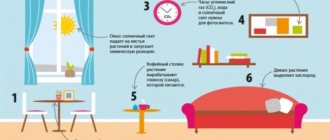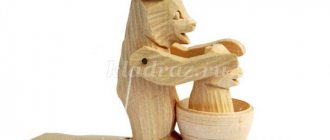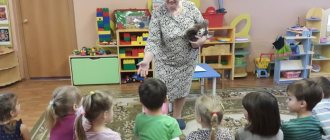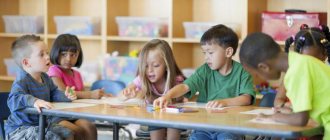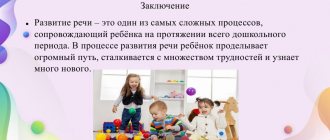“I’m going on a hike and taking with me...”
The driver says the first phrase: “I’m going on a hike and taking with me...” Then he adds any word that suits the meaning. The next player repeats the phrase and adds a word of his own.
The game continues until the players are able to repeat the entire phrase.
Example: “I’m going on a hike and taking with me... a bowler hat.”
“I go camping and take a bowler hat and matches with me.”
“I’m going on a hike and take a pot, matches and a knife with me,” etc.
By the way, the first phrase can be not only about the hike. For example: “I go to the store and buy there...”, “I go to visit and take with me...”, etc.
Card index of didactic games card index of the world around us (senior group) on the topic
Card index of didactic games
"What is good and what is bad".
Goals: To teach children to distinguish good behavior from bad; Pay attention to the fact that good behavior brings joy and health to both yourself and the people around you, and, conversely, bad behavior can lead to unhappiness and illness.
Demonstration material: Excerpts from their works of art, life facts about the good and bad behavior of a person, children, or group.
Progress of the game: Children use facial expressions and gestures to express their attitude towards good and bad behavior (bad behavior - make an angry face, shake a finger; good behavior - smile, nod their heads approvingly). Answer the teacher's questions.
Sample questions: Today Seryozha ate snow again. Guys, is this good or bad? Children show with facial expressions and gestures that this is bad.
What could happen to Seryozha? The children answer.
"Noble Deeds"
Goal: To cultivate in children the desire to do things for the sake of other people. To form an understanding that we call an action not only heroism, but also any good deed for the sake of another person.
Material: ball
Progress of the game: Children are asked to list noble deeds towards girls (women) and boys (men). The teacher throws the ball into the hands of one of the players, he names a noble deed and throws the ball to the next player at his request.
For example, noble deeds for boys: call a girl only by her name; when meeting a girl, say hello first; give up your seat in transport; never offend a girl; protect the girl; help the girl carry heavy things; when a girl gets out of the transport, you need to get out first and give her your hand; the boy must help the girl get dressed, give her a coat, etc.
Noble deeds for girls: call a boy by name only; when meeting a boy, say hello; praise the boy for showing attention; do not offend or call the boy names, especially in the presence of other children; thank the boy for his good deeds and deeds; etc.
"Bag of Bad Deeds"
Progress of the game: Children receive black paper blots, the teacher offers to put them in a bag, and tell them what bad things he did today, as well as put negative emotions in this bag: anger, resentment, sadness. And when the children go for a walk, this bag is thrown away.
"Flower of Good Deeds"
Material: flower made of multi-colored cardboard, the petals are removable and inserted into the middle.
Progress of the game: You can play the game individually with a child, or with a group of children. Children are invited to collect the “Flower of Good Deeds”; for this, each child needs to take a petal and say some good deeds. Children list positive actions one by one, and the adult connects the petals to the middle. When the flower is collected, the children applaud each other.
“How do I help at home?”
Objectives: To form ideas about the household responsibilities of women and men, girls and boys. Cultivate a desire to help people.
Material: flower made of multi-colored cardboard, petals are removable, inserted into the middle
Progress of the game: Children take turns tearing petals from a flower, naming the duties they perform in the family (watering flowers, sweeping the floor, caring for animals, “raising” younger sisters and brothers, repairing toys, etc.). You can diversify the game. Let the children list the responsibilities that their mothers and then their fathers perform in the family.
"Let's compliment each other"
Goals: To teach children to be attentive to each other, to be able to show sympathy for children of the same and opposite sex. To consolidate knowledge about the qualities of masculinity and femininity.
Material: Any flower (it is better if it is not artificial, but live).
Progress of the game: The teacher brings a “Magic Flower” that will help the children express their feelings. Children are encouraged to pass the flower to any child and compliment them. If someone is ignored, the teacher pays a compliment to these children.
"Wishes"
Goals: To teach children to be attentive to each other, to be able to show sympathy for children of the same and opposite sex. To consolidate knowledge about the qualities of masculinity and femininity.
Material: heart toy (any toy)
How to play: Children stand in a circle. Passing a toy to each other, they say their wishes: “I wish you...”
Didactic games for children 3-7 years old
Brief description of the document:
Didactic games for children 3-7 years old
For the development of socialization
Didactic game “Good or bad deed”
Goal: to develop adequate evaluative activity of preschoolers, aimed at analyzing their own behavior and the actions of people around them, the ability to evaluate positive and negative actions.
Procedure: Children receive pictures with images of good and bad deeds, place them on a magnetic board with a cloud (bad deeds) or on a board with a sun (good deeds) and explain their choice.
For the development of cultural and everyday skills
Didactic game “Clean children”
Purpose: To test children's knowledge about hygiene items and their purpose.
Procedure: The teacher tells the children that she wants to make sure that they are clean and tidy: let them say what it takes to keep their hair, hands and face clean (the more they can tell about this, the better).
Then the teacher says: “Hands.” The children she calls answer: “Soap, brush, towel.”
In a similar way, children react to the words “hair” (comb, brush, scissors, shampoo, soap).
“Bathing” (bath, towel, shower, washbasin, sponge, soap, etc.).
2 Option to start the game.
The teacher asks the question: “What do we need when we get up in the morning?” Children know that they must name hygiene items that are used in the morning (hand brush, toothpaste, soap, handkerchief, etc.)
For the development of cognitive abilities
Goals: to develop visual perception of shape, attention, memory, repeat colors, names of geometric shapes, develop imagination.
Come up with a picture
The teacher asks the children to first trace a geometric figure: “Trace the circle.” Then he invites the children to think, remember what objects they know that are similar in shape to a circle, and complete the circle they have. “What looks like a circle. Finish it." “Draw.” Children complete the task and report on what they drew, answering the teacher’s question: “What is this? What did you draw? "Sun. Ball". Children can use signs written by the teacher to answer questions if they find it difficult to answer on their own. First, the teacher can show several options for finishing the drawing and compare it with real objects. Then the children must complete the task independently. The teacher can direct children's attention to the objects around them to highlight among them an object of the required shape.
Draw an ornament
The teacher invites the children to create a specific ornament, or at the request of the children themselves, using geometric shapes cut out of cardboard.
Then the teacher makes up an ornament, and the children try to draw it on a piece of paper. At the end of the game, children's works are examined, children talk about the geometric shapes used in the ornament: “This is an oval, then a square, this is a circle, etc.”
What changed?
The teacher lays out various objects in a certain sequence, for example, geometric shapes or cubes of different colors and shapes. Then he invites the children to carefully examine and remember the order in which they are located. Then he closes it with a screen, behind the screen he changes the order of the objects, moves the screen aside and invites the children to see if everything is correct, as it was: “So it was? What changed?". Children find changes and correct them. They can also lay out the sequence they saw at the beginning from the objects they have.
